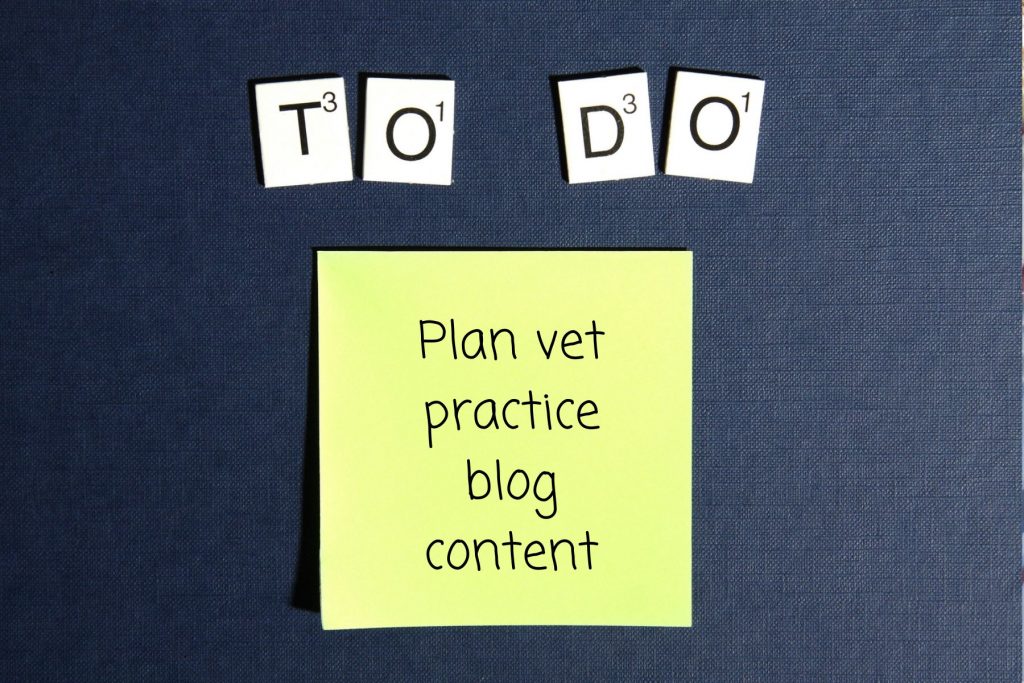If you’re a veterinary practice, mobile vet, or locum veterinarian looking to make their digital presence more visible, then you need veterinary SEO. This guide will walk you through everything you need to know about SEO, and give you some ideas of what to do next. We’ll also link out to a number of our other guides on SEO for vets, so you can delve deeper.
Do vet practices need SEO?
Before we get started, we should probably tackle whether your vet practice needs SEO. I’m assuming, since you’re here, that you think you do, but let’s clear up a few things:
SEO is the practice of tweaking your website to make it show up better in search engine results.
Every veterinary practice with a website that wants customers needs SEO to some degree. If you’re the only practice in your region, and you show up at the top spot for search when customers look for “vet in [location]” then you probably don’t need much in the way of veterinary SEO. However, if you’re not in the top spot, and you have competition for your service, then SEO is worthwhile. It’s everything from making sure you show up for “vet in [location]” queries through to getting clicks and building trust with customers who are searching for “puppy vaccination schedule” in the hope they’ll choose you.
SEO for mobile vets
No physical location? No problem! Actually, mobile vets and house-call vets need SEO more than most veterinarians and veterinary practices – with a wider catchment, and no building to help advertise them, they rely on digital marketing more than most. The sections below are just as relevant – if not more relevant – for mobile vet clinics, house-call veterinarians, palliative care, hospice and euthanasia vets, and peripatetic veterinarians.
Technical SEO for veterinarians
Google’s bots are a lot like nervous spaniels – if your site is slow, confusing, or broken they’ll run off before they find the good stuff. Get the tech foundations right and every other SEO win (on-page, local, content) becomes much easier.
And what about your customer? Well, pet owners are often stressed, on a phone, and in a hurry. If your page takes five seconds to load or your booking form glitches, they’ll bounce to the clinic down the road or reach for the phone – Google notices that pogo-stick behaviour and moves you down the results page. For mobile vets, your website is the waiting room, so a rock-solid technical setup directly translates to calls and consults. So what do you need to do?
1. Build a crawlable, logical site by checking your URLs and sitemaps
Google wants to show users the most appropriate result – but if your website is a confusing mess, the robots are going to struggle to know what you do and why. Start by making sure everything is logical, then make sure Google has a map to your site. Here’s what to do:
- Run Google Search Console’s “Page Index” report – it highlights any pages the bot couldn’t reach and tells you why. Go through and fix them.
- Scan your URL slugs: keep them human-readable (
/services/dog-vaccinations/) and nest pages logically under /services/ or /blog/. Logical organisation is key. Make sure, if you’re changing URL’s, that you have redirects set up so you don’t end up with too many broken pages. - Use a one-click XML-sitemap generator (I like the super-user-friendly Yoast SEO, but RankMath or Screaming Frog’s free crawl will do the same thing). This lists every page in a neat file (
/sitemap.xml). - Submit that sitemap back to Search Console so Google always has the up-to-date map.
I know this sounds like a jumble of mumbo-jumbo, but trust me – it helps! And once you get started you’ll realise it’s actually not as hard as it sounds.
2. Optimise security – HTTPS
I almost left this one off because it’s now such a basic requirement for a website that it’s barely worth saying. But it’s an important one, so just in case anybody is still running their website without an SSL certificate – you need one. If pet owners click on links without https, their browser will warn them – and if you’ve never seen it before, it’s a scary warning about hackers stealing data – and their trust will evaporate.
- Check your website’s URL – if it starts with HTTP://, you need to sort out a certificate. If it’s HTTPS://, you’re (probably) all fine.
- Run your domain through the ssllabs free checker, which will check your SSL certificate is set up correctly.
Found out you don’t have an SSL certificate? Talk to your hosting provider, who may be able to activate one, or you can use the ‘Let’s Encrypt’ button on the ssllabs page to get started.
3. Speed up your website
You know the feeling – you click, wait several seconds to load, then get bored and try elsewhere? That’s universal. Unless pet owners are 100% sure you are what they’re looking for – and are therefore fine with waiting for it to load – they’re going to click back and try elsewhere. And Google notices those signals. So fast page loads matter to Google, and to your SEO!
- Check Core Web Vitals report on Google’s Search Console – see which batches of pages Google says are “Poor” or “Needs improvement” on Mobile vs Desktop; fix the worst group first.
- Shrink big images before uploading (export “web” or “compressed” from your photo tool); large hero photos are a common LCP killer highlighted in both PageSpeed and Core Web Vitals reports.
- Run your homepage through PageSpeed Insights – paste the URL, click Analyze, and note the colour (green/yellow/red) plus the “Opportunities” suggestions; repeat for key service pages.
- Make sure you have caching – A cache is like a memory of the website – so it doesn’t have to load from scratch every time. Make sure you have caching by talking to your hosting provider.
On-page SEO for vets
So, now we’ve got the technical website-y bit out the way, let’s look at your on-page SEO. On-page SEO is what you can write on each page to make your website more visible to search engines.
Main website pages
The main pages of your website (eg ‘Home’, ‘Services’, Contact’, and ‘About Us’, need to be optimised for search. They’ll need to have the right combination of subheadings and text, and keywords for your site throughout. For example, the beginning of a practice homepage might read
“XXX Vets have been offering the highest quality vet care for over 80 years. Our independent practice of vets, RVNS and nursing assistants is extremely well equipped to deal with all your veterinary needs.”
But it doesn’t contain any keywords. It could be rewritten:
“XXX Vets have been providing the best veterinary care in [region/city] for over 80 years. We regularly invest in our equipment and staff, and are one of the only independent vets in [city/area/region].”
In this way, the keywords ‘vets in [region]’ and ‘independent vets in [region]’ as well as the synonym ‘veterinary care in [region]’ are in the opening line of the website, and they instantly build authority and trust.
Rewriting your practice’s website can seem like hard work, but small tweaks can make a huge difference. Try to assign one unique keyword per page and then use more general keywords throughout. Some website builders have SEO help built in, or you may be able to install a plugin to help – we use Yoast. If you need help deciding where to make adjustments, and what to write, consider outsourcing to one of our veterinary copywriters, who will work with you to rewrite your pages.
Content strategy
What about your blog? Well, we definitely recommend having some sort of regular posting happening to your website – it helps you stay current in Google’s mind. ‘Regular’ can be just one post a month, but we recommend two or more if you can manage it. One can be practice news, but for optimal SEO it’s best to have at least one a month that helps to use your SEO keywords and build trust with clients. The more ‘evergreen’ your posts are, the longer they’ll help your practice out – so plan content that won’t go out of date easily.
Need more help? Try Content Planning for your Vet Practice – TVCC or
Keyword research
Before you can do on-page SEO, you’ll need to do some keyword research. That means finding out what your customers are searching for when they need your services. For most vet practices, some combination of ‘vets in [region]’ will be important, but depending on your service there may be other phrases that are important. If you’re a vaccination clinic, you might want to target ‘what vaccinations does my puppy need?’, and if you’re a mobile vet specialising in euthanasia, keywords around ‘how to tell when it’s time to say goodbye’ will help you get seen by your clients. Some of these will be better suited as blog posts, while others will be your main service pages.
Here’s an article to help you find the keywords your vet practice needs: 5 ways to find veterinary keywords for your clinic – TVCC
Off-page SEO, Local SEO, and digital PR
Getting seen beyond your own website builds authority and trust—two signals Google uses to decide which local vets to surface. It’s an important – and often forgotten – part of veterinary SEO, but it’s harder to implement, because you aren’t directly in control of so much. So how can you build your practice’s visibility online without touching a thing on your own page?
- Claim & complete your Google Business Profile. Make sure your practice’s name, phone, service area, after-hours info, and booking link are correct, and add real clinic and team photos. This is the bit that shows up when people use maps to search, so it’s worth getting it right!
- List your clinic in trusted directories & vet registers. You’re probably already on the RCVS Find a Vet page, which is great, but joining other vet registers like the one at VetHelpDirect helps build your online presence. Similarly, online directories like Yell, Yelp, and Thomson Local can be helpful. You’ll need to make sure they’re kept up to date, so keep a note of which directories you’re using to make it easier to make changes to things like opening times and avoid frustrating customers.
- Ask every happy client for a Google review. Hand them a QR card or text a link after appointments. Photos of their pet in your care add credibility and can influence which snippets show in search – if it fits with your veterinary brand, why not set up a little photo booth in reception to encourage them to take photos and spread the word. Respond to all reviews – good and bad – to show you’re listening. The VDS are a great source of advice for dealing with bad reviews.
- Engage in some simple PR. Getting the whole web talking positively about your practice is hard, but some simple PR can go a long way to building your authority. Ask your local press whether one of your vets can have a column or whether they accept occasional interesting pet stories. There are also other ways you can get websites and brands mentioning your practice – speak to us about veterinary PR.
AI optimisation for veterinary practices
‘What about AI search?‘ I hear you say. ‘Isn’t SEO dead?‘. Well, no. Firstly, the vast majority of people still use search tools, so it’s important to cater to the majority. Estimates suggest for every ‘search’ in genAI tools, over 300 searches happen in Google still. Don’t ignore the 300 chasing the one!
Secondly, early indications show that AI search bots follow very similar processes in terms of deciding what to turn up in results. They still value Authority and Trust signals. They put a lot of emphasis on reviews and even recommendations from social media posts and Reddit. Here are some tips about AI search for vet practices, from what we know so far:
- Don’t stop SEO – AIO is following similar rules, so if it’s good for Google it’s likely good for AI too.
- Make sure your content is conversational in style and using/answering FAQs – AI likes these
- Double down on your PR, especially on reviews
You can find out how your vet practice is currently showing up in AI responses using Hubspot’s free tool. It takes some fiddling to get the inputs right!
Top tip: If you’re getting ‘0’ for ‘share of voice’ and it isn’t listing your competitors, then change the ‘industry’ you put in until it starts to look closer to your competitor mix.
Measuring your veterinary SEO
There’s little point in making your changes and not seeing whether they’re working for you. Whilst there are hundreds of SEO tools out there, the free Google Search Console will tell you most of what you need to know.
Keep an eye on your impressions (how many searches you show up for), your clicks (how many people click to your website), and your position (how high up the results page you’re coming in). You can see the phrases people were searching for when you showed in their results – if they’re not the people you need, it’s time to fiddle with your veterinary SEO. You can also filter the results for pages – eg which keywords people use when they find your homepage or your ‘services’ page – or for queries. I like using ‘query not including’ to remove vet practice names from the search query/keyword – this helps me see more accurately how a company is faring against its competitors for more general queries, like ‘vets in [region]’.
Conclusion
Veterinary SEO isn’t brain surgery, but it’s pretty complicated all the same as so many things influence search engine algorithms. We’re the experts when it comes to on-page SEO – that’s everything written on the pages and posts of your website – so if our extensive knowledgebase isn’t helping, or the above sounds too much like hard work, get in touch and let us know what you need.
The Complete Guide to Veterinary SEO (2025)
If you’re a veterinary practice, mobile vet, or locum veterinarian looking to make their digital…
Vet SEO – 4 top tips from a veterinary content strategist
If you’re a veterinary practice or company struggling with your vet SEO, you’ve come to…
SEO for the vet industry – what you need to know in 2024
Whether you’re a mobile vet practice, a small branch, or part of a huge corporate…
Content Planning for your Vet Practice
Your digital content is an important part of the marketing strategy for your business but…
Running Great Vet Email Campaigns (Our Top Tips)
If you’re a vet practice manager, owner, or marketer, you might already be contacting clients…
Marketing for Veterinarians: Making a Marketing Plan
For some vets, marketing can feel like a challenge. With so many bits of jargon…








